Performance Review
Samantics & Sacramento Contemporary Dance Theatre
EMBODIMENT - January 11, 2018
What happens when two extraordinarily creative people bridge the gap between the world of modern dance and the world of choral music? What happens is that you get EMBODIMENT. I’ve been a fan of Jacob Gutierrez-Montoya’s choreography since I saw it displayed in his production of Human Nature, first staged by the Hawkins School of Performing Arts in 2015. And I’ve been delighted by the witty, imaginative and thoroughly entertaining concerts of Sam Schieber’s Samantics choir since 2011. Then when Schieber took the bold step of writing a serious major choral work in 2016, I was dazzled by the first performance of In Paradisum, and then dazzled again when it was reprised a year later.
Somehow these men found each other and got the idea of choreographing In Paradisum. It was an example of these words by Meister Eckhart (c. 1260 - c. 1328): “It’s time to start something new and trust the magic of beginnings.” And it was indeed theatrical magic that evolved on the stage of the Jill Solberg Performing Arts Theater at Folsom High School on this night (and the night following).
In Paradisum has evolved with a few deletions and additions since its premiere, but tonight it consisted of 21 movements. It is essentially a contemporary requiem, so many of the movements have the titles and text (in Latin) of the requiem mass. Supplementing them are several movements based on the poetry of medieval English poet, George Herbert, plus a few additional movements which will be described presently. Obviously, this is serious, sacred music — though spiced with several moments of whimsy. So why title the show “Embodiment”? I still haven’t thought this completely through, but my working hypothesis is that the forms and movement of the dancers give body to the emotions and messages of the music.
As I sat waiting for the performance to begin, I was concerned. Most audience members had been given a short “program” that included only a message from Director Montoya, the names of dancers and singers, acknowledgment of support staff, and a list of those to whom special thanks was due. There was nothing to alert them to the content of the music. However, a few of us managed to obtain a singer-oriented program, which gave a list of the musical sections, plus text and translations, acknowledgment of soloists, the history of In Paradisum, and background on the Samantics chorus.
(Click here to open this program in a new window; click here to open the abbreviated program in a new window.)
My concern was that I was worried how the audience could possibly
understand nature of the music. Even those who had the detailed program
couldn’t refer to it in the dark of the theater. The singers were not on
mic and were far from the audience, so it would be hard to make out
their words. And the audience’s focus would be on the downstage movement
of the dancers, even if they could make out the lyrics that were being
sung. But maybe a general idea of the religious content would be all
that would be necessary for the audience. Still, that thought saddened
me because I knew that much thought went into choosing which movements
to include in the piece. And I knew, too, that there was a logic in
their sequence. And the lyrics — whether in Latin or not — would have a
message or emotion that would be integral to the music. If the audience
heard the music as just “beautiful” or "exciting," they would be missing
the point: each section of the music had a message, as would every bit
of choreography in the show.
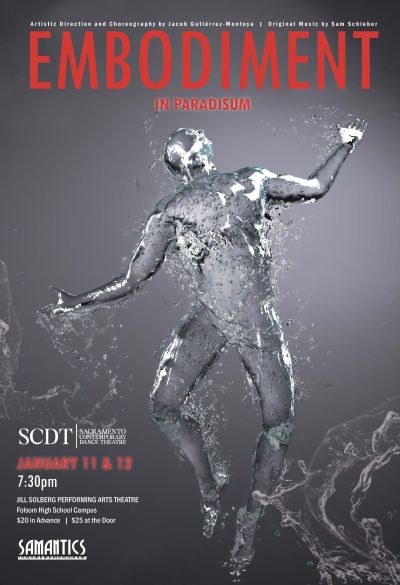
When the curtain rose, it revealed the 39-member chorus (plus 5 guest soloists) well upstage on two sets of risers separated by a piano. That’s where Sam Schieber sat, playing all the accompaniment for the singers — and giving occasional director’s cues with a free hand. “Requiem Aeternam” was the first movement, and although the message of “requiem” is hopeful (“Eternal rest give unto them, O Lord”), the subject is death, after all. And the eleven dancers, dressed in white, with a soloist in blue, were appropriately somber in their movements and demeanor.
The choreography was visually arresting from the moment the performance began, and sorry to say, singers, but you were in the background, not only physically, but as far as the audience’s attention was concerned. This was “contemporary dance,” and so the movements of the dancers were generally free and expansive, more often than not independent of one another, and with different parts of their bodies (besides their feet) in contact with the stage. It was a visual feast, and as the performance progressed, we were treated to one unique choreographic “dish” after another.
At the conclusion of “Requiem Aeternam,” the dancers scattered, some actually rolling offstage. Then “Kyrie” began, the first of several solos by Natasha Collier in which she demonstrated a beautiful, pure soprano voice and a sensitive interpretation of the text. For their part, the 6 dancers in this section seemed initially reverential (helped by a bit of stage fog), eventually becoming exultant — or so it seemed to me.
A couple of points to make here. First, there were many incidental vocal solos and small ensembles in this performance — both from chorus members and from the guest soloists. There was so much happening downstage that it was impossible to analyze most of these performances, except to note the general impression they created, which I’ll try to do in what follows. Secondly, it’s also impossible to describe all the dazzlingly innovative choreography. It felt like I was seeing — one after another — dance moves that I had never seen before, and couldn’t even imagine. And the innovation extended to the use of colors, costumes and props — about which I’ll comment as much as I can.
The choreography for the next several movements was built around three 4-foot benches, and I marveled at all that the dancers could do with these props. Meanwhile, like the variety in the choreographic use of the props, there was extraordinary variety in styles of the music: “Pie Jesu” was a sweet duet by Autumn Malone and Madeleine Wieland; “Antiphon” was a lyric piece with the chorus backing a dialog between men and women soloists; then “Gentle Jesus” highlighted 4 soloists with a flowing piano part. The dancers in this last piece were dressed in black costumes that completely covered their bodies, evoking the character of nuns — though their movements were far from nun-like.
Then with its pronounced rhythm, “Recordare” felt like music written for ballroom dancing, but with contemporary harmonies and stylings, all with the chorus supporting another excellent solo performance by Natasha Collier. Meanwhile the principal dancer performed in a bright red costume with an impossibly long and wide train that became a prop for 7 other dancers in black outfits. I should mention that except for the dancers that made me think of nuns, the costumes and choreography in the first part of this performance seemed like a presentation of abstract art, and not evocative of anything specific. That said, throughout most of the first act of this program, it was a constant challenge to understand what the choreography was trying to convey. For the chorus and vocal soloists, there were lyrics to help one understand the meaning in their singing. But dance has its own language, and as I struggled to understand how the choreography related to the lyrics of the music, I guess I had to conclude that not every emotion, not every thought in the language of dance, can be translated into words in order to convey meaning to the observer.
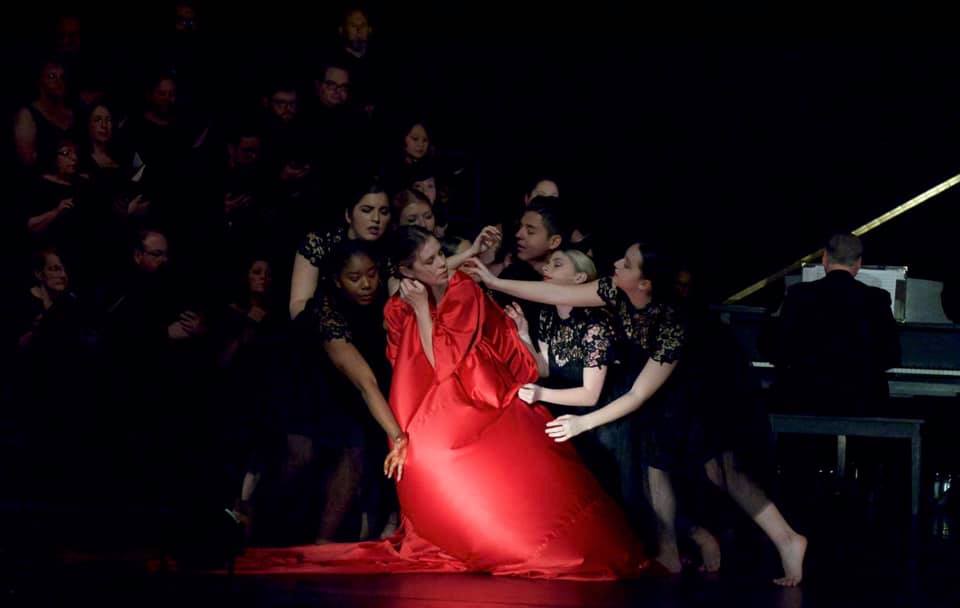 |
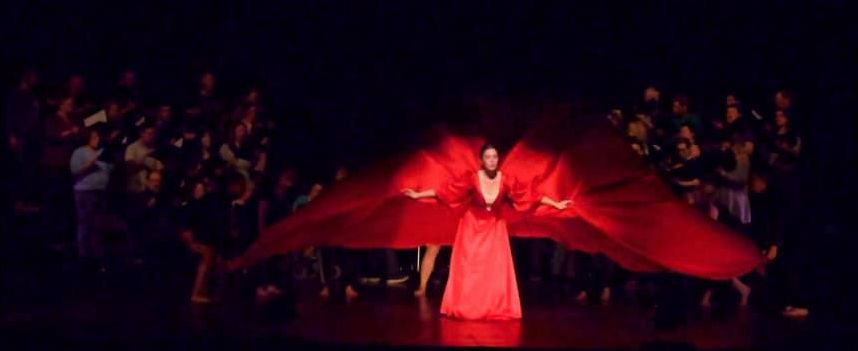 |
Indeed, although the Latin text of the “Agnus Dei” came through clearly to me at the back of the audience, I got only snatches of Sam Schieber’s excellent lyrics to the following piece, "The Lost Sheep," his setting of this parable of the one lost sheep from Luke 15:3-7. It was a playful, contemporary-sounding ballad. Fortunately, I’d heard it before, and this time after the soloist (in this case Kimberly Edington) sings most of the story, the part of the lost sheep is sung as a descant (this time by Lisa Snow). Meanwhile Jacob Gutierrez-Montoya had his dancers moving in lines across the stage in a way that looked like a galloping crawl, meant to indicate a parade of sheep. It was brilliant! I wrote in my notes: “It's remarkable how many ways in which the human body can move!”
The show took a somber turn in “Virtue,” in which a light musical score accompanied a George Herbert poem about mortality and immortality. For choreography, a dancer in black went through a succession of partners, as the first three stanzas of the poem ended in the words “must die.” The next movement, “Graduale: Requiem Aeternam,” undertook a more hopeful message in a duet between Natasha Collier and Maureen Mette, and it was the first time I could distinguish the lovely singing of Mette. The choreography focused on a single dancer, dressed in black, holding what appeared to be a black, leather-bound book, clearly representing The Bible. She danced energetically, occasionally opening the book, and finally clutching it to her breast.
Then came the final number of the first act that left most of us in the audience completely dumbstruck. “Praise” was sung by Brad Bong, an actor and singer who came from New York City to perform in this work by his former voice teacher. Schieber wrote “Praise” for Bong especially for this occasion, and Bong gave a forceful, expressive performance of this setting of another George Herbert poem. Still, I fear he was profoundly upstaged by the choreography. Three dancers entered, more scantily clad than previously, carrying bowls of water. Their movements involved straight chairs and the bowls, into which they dipped their hands at various points in their routine. Then 8 more dancers entered with their own bowls. Presently, they were flinging water into the air at the end of musical phrases, and amid a myriad of other dance moves, they dipped their heads in the bowls, and poured the remaining water on themselves at the conclusion of the number. Clearly, everyone had been baptized. I couldn’t keep from laughing — not from any humor in the situation, but from surprise — which was felt equally by all around me. We had seen something totally unexpected, unpredictable — and this was only half-way through this remarkable show.
 |
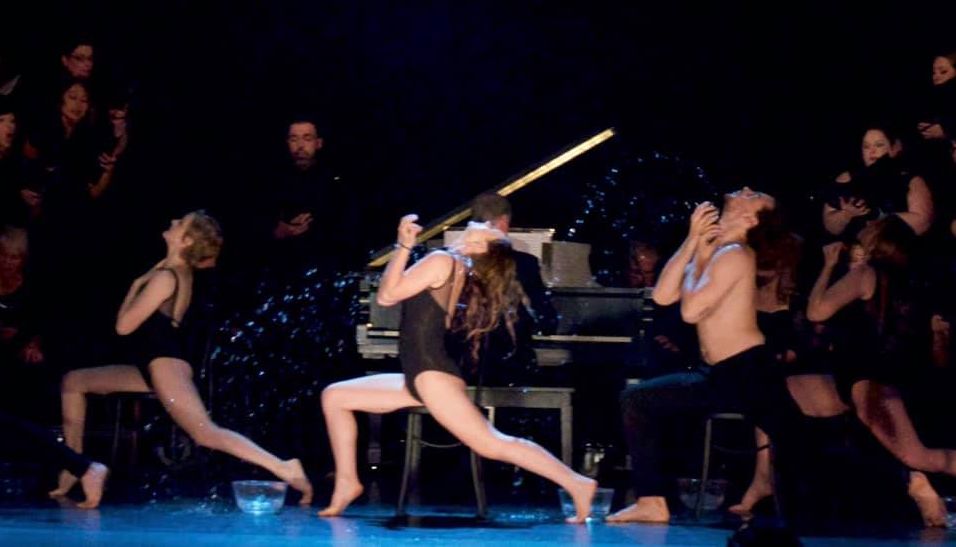 |
The first selection of Act Two, “Sanctus,” began with what was, to me, a distinctly classical style. With clear articulation and a fine baritone voice that carried through the theater, Robert Rennicks sang text from the book of Revelation before the full chorus joined him with an impressive display of choral power. Meanwhile, a male dancer in a minimal, flesh-colored costume performed in front of a four-sided, 10-foot high structure with openings in its “walls,” through which dancers were moving sinuously. The male dancer was soon joined by a female dancer in a similar flesh-colored costume, and I quickly realized that I was looking at Adam and Eve. The music being sung was Revelation, but the choreography was Genesis. Then came a wonderful, daring effect from the chorus. The singers broke into bird calls and animal sounds, representing not only the Creation of Genesis but the reference to the creatures in Revelation 5:13. It was a daring choral effect that is so characteristic of the adventurous mind of Sam Schieber. Then “Sanctus,” perhaps the grandest movement of “In Paradisum,” proceeded to a stirring conclusion, when a female dancer, dressed all in black, entered holding a bright red apple.
The following selection, “Life,” was a simple, melodic song to another poem by George Herbert that made a non-religious comment on mortality. Tenor Quin Smith gave a strong performance of this brief piece, while “Adam” and “Eve” continued their interactions with “the serpent.” After a reprise of “Pie Jesu,” there was intense drama in the music of “Lacrimosa,” with heavy base chords from the piano, plaintive singing from the chorus, and honest-to-goodness wailing from soloists Maureen Mette and Lisa Singh. Meanwhile, “Eve” was interacting with “the serpent,” taking the apple from it, and dancing while holding the apple in her mouth. As the music ended, Eve was transferring the apple to Adam, mouth-to-mouth.
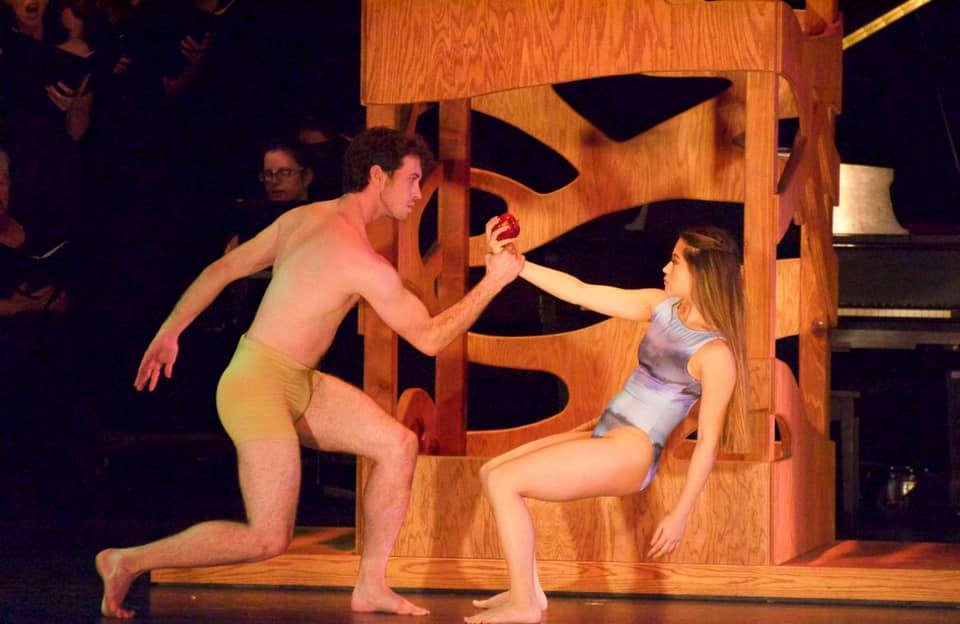 |
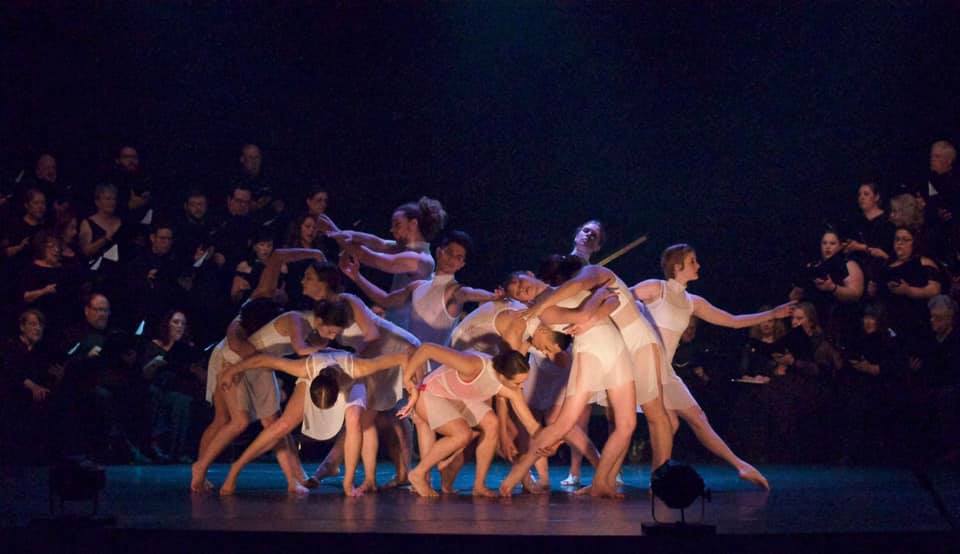 |
“Hostias” was another “wow” scene from this dance troupe. It began with a dramatic building chord from the chorus, and the music that followed reminded me of other requiems that I’ve heard from classical composers. As for the 8 dancers, they spread out in a line across the stage and looked up while 8 bright red apples descended to them from above. Each dancer took their apple as a prop in the choreography that followed, taking occasional bites, and concluding by appearing to commit to eating the whole apple. I didn’t see how the choreography represented the text of the music, which expressed the hope of eternal life for the departed. No matter. Visually, it was nothing short of compelling.
The music of “Lux Aeterna” had the ethereal quality that characterizes parts of Fauré’s Requiem. The accompanying choreography featured 7 dancers in white, moving and twirling gracefully, with occasional acrobatic moves. Then “Psalm 130,” essentially a plea for mercy, presented some of the most dramatic choral singing of the evening, alternating with some delightful melodies. As for the dancers, it began with what looked like the whole company, dressed in white, in a tight tableau. Among them was the principal dancer, different from the rest in that, showing below her white, gauze-like outer garment were red undergarments. Throughout the choreography she appeared to be seeking redemption, though at the end, the 12 other dancers seem not to have accepted her.
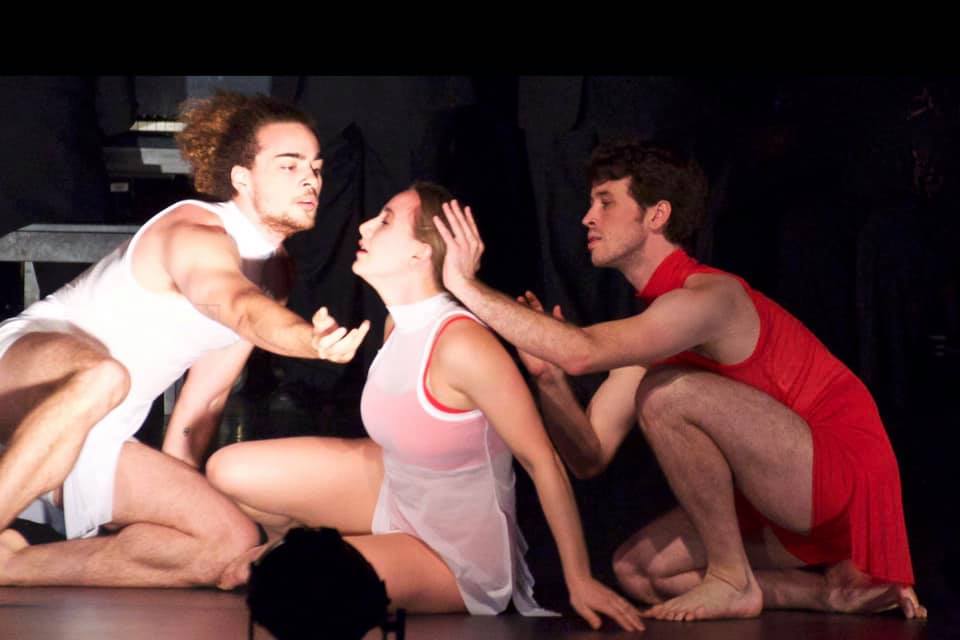 |
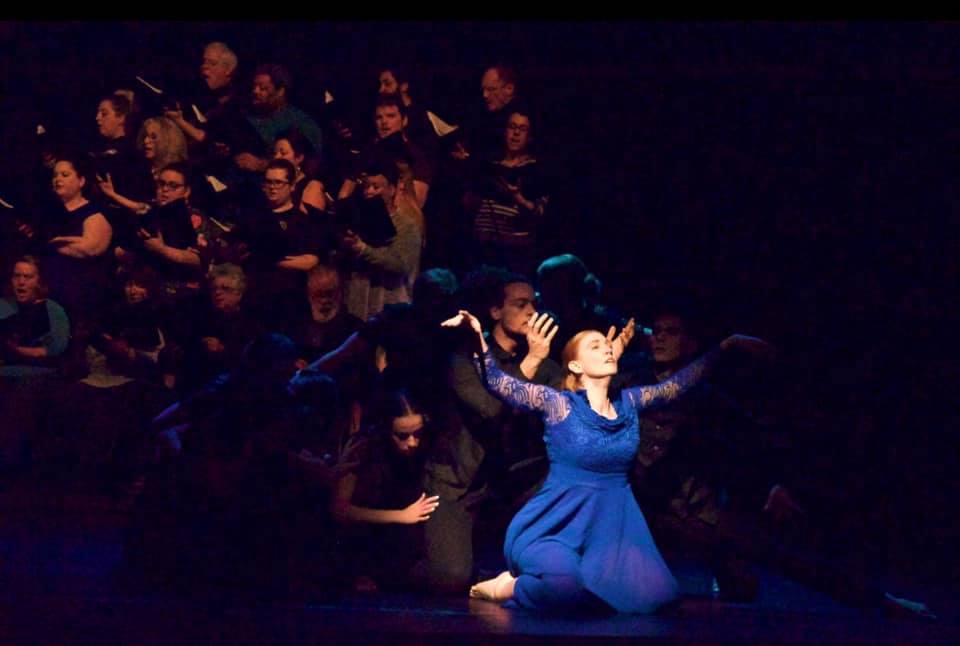 |
“Libera Me” continued this personal drama, with soprano Maureen Mette giving a moving, plaintive voice to the anguish being portrayed by the dancer. Then with regular pulses of bass notes from the piano, 7 dancers in red entered, and their choreography seemed to represent temptation or some evil influence. At this intense moment in the performance, I tore myself away from watching what was on the stage, long enough to write “The drama produced by chorus, dancers and piano is profound.” Presently, dancers in white entered to struggle over the “sinner.” Soon though, it was just two male dancers, one in red and one in white, trying to win over the “sinner.” In the midst of all this symbolism, the significance of this massive production became clear to me. Music and lyrics, especially lyrics in Latin or early English, can be moving on their own, especially with study, repetition and careful attention. But choreography can enhance appreciation. I was seeing how the thoughtful, emotive and artistic movement of the dancers was bringing out the humanity inherent in the music and reaching audience members in a more fundamental way than might otherwise be achieved on a first or casual hearing of the music alone.
Having heard In Paradisum performed twice before, I was keen to hear the new finale, “Hosanna in Excelsis” that was added in honor of this collaboration with the Sacramento Contemporary Dance Theatre. It was a grand ending to this piece of music, full of choral energy that transferred into extra energy for the dancers. For this final piece, as if to express the reconciliation of black and red, the dancers, all of whom were on stage, were dressed in neutral colors. Their ensemble choreography was impressive, with smiles on each face, expressing the elation they all must have felt. Had the chorus not been singing, they would have been smiling, too. And with the final chords of the music, the audience, all on their feet, erupted in waves of cheers.
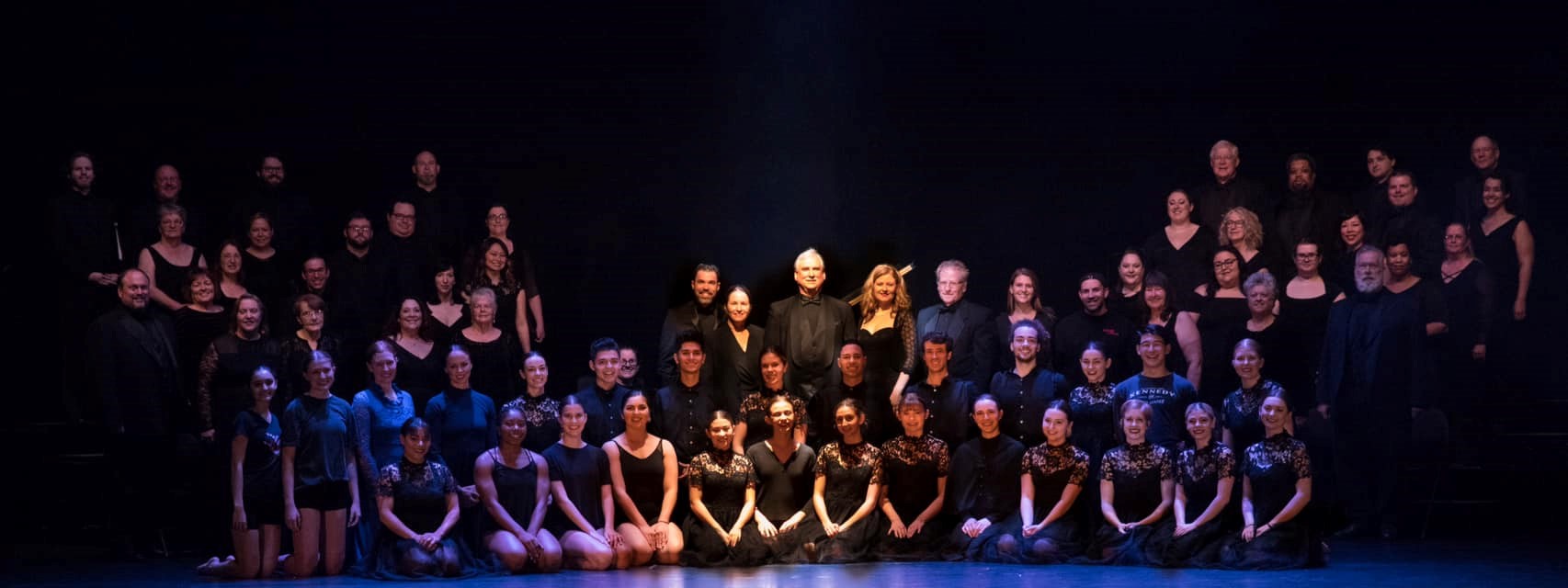
It felt like a once-in-a-lifetime event: a modern requiem with beauty, drama and energy, completely new, but drawing on many musical traditions and married with a non-stop dance performance that was exciting, boldly innovative, full of grace, power and emotion and simply kaleidoscopic. It’s what happens when two masters of creativity decide to do something that has never been done before, with the help of nearly one hundred committed vocal and dance artists. I watched and heard it all, and it left me breathless.
Notes: You can find more pictures of this show in the Sacramento Contemporary Dance Theatre's Facebook page (https://www.facebook.com/SACCDT). Also you can contact them at (www.SCDtheatre.org) for a video of this performance. Recordings of In Paradisum are on YouTube, and downloadable from ITunes and Amazon.com. For more information on Samantics, visit www.samanticschoir.com.
Dick Frantzreb is past editor of the Sacramento Choral Calendar and co-founder and past President of the Sacramento Valley Choral Coalition. He currently edits the Placer Performance Calendar and the new Capital Region Performance Gallery. He has been loving live performances in the greater Sacramento area and writing about them since 2012.